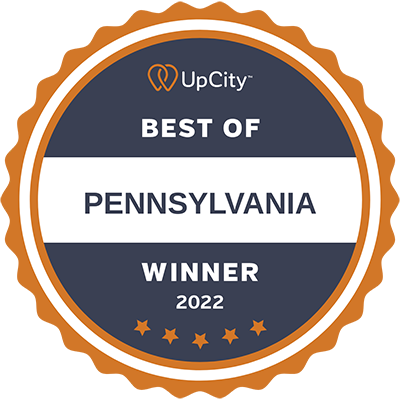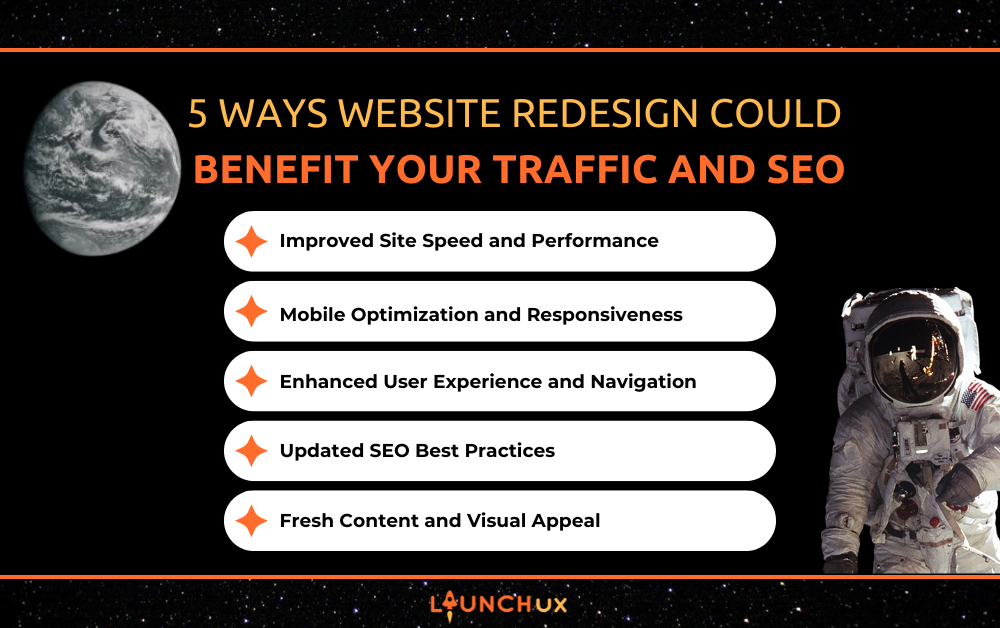Your website is frequently the first initial interaction potential customers have with your brand. At LaunchUX, an innovative and strategic website redesign can do much more than just improve how your site looks. When executed correctly, it enhances search engine performance, strengthens user engagement, and drives more qualified traffic. Whether your site is outdated, slow, or simply no longer meeting user expectations, a redesign provides the perfect opportunity to refresh both the user experience and technical foundation. With SEO baked into the process, you can expect long-term visibility gains and increased organic traffic. In this blog, we’ll explore five essential ways a website redesign can benefit your traffic and SEO.
Improved Site Speed and Performance
Why Speed Matters for SEO
Website speed has evolved ro become a critical factor in search engine ranking algorithms, and it directly affects user satisfaction. A slow website frustrates visitors, causes them to bounce quickly, and sends negative signals to search engines. During a redesign, elements such as unoptimized code, oversized images, and outdated plugins are typically addressed to boost speed. These changes help improve loading times and make your site more efficient and responsive. Quicker websites not only perform better in search results but also encourage users to engage with more content. Ultimately, quicker websites build trust and helps improve both SEO and conversion rates.
Engaging Visitors Through Performance
When your website performs well, users are more likely to stick around, explore different sections, and complete actions such as signing up or making a purchase. Redesigning your site with performance in mind allows you to implement new technologies like lazy loading, compressed files, and CDN integration. These methods greatly diminish the time it takes for your pages to load fully. The longer users stay on your site, the more favorable signals are transmitted to search engines, which can lead to higher rankings. In turn, improved rankings can bring in more targeted traffic. This creates a cycle of performance-driven growth for your digital presence.
Staying Competitive Online
Your competitors are constantly upgrading their digital platforms, and if your site lags behind, it could cost you valuable traffic and business. A website redesign positions your brand as modern, trustworthy, and professional—qualities that users and search engines both reward. Additionally, improving load speed across devices helps ensure that mobile and desktop visitors get the same high-quality experience. In competitive industries, even a one-second delay in page load time can mean losing a lead to a faster site. By staying on top of performance trends during your redesign, you’re investing in long-term visibility and customer retention.
Mobile Optimization and Responsiveness
Adapting to Mobile-First Indexing
With Google’s mobile-first indexing, your site’s mobile version is now the primary version evaluated by search engines. That means if your site isn’t optimized for mobile, you could be losing visibility and rankings, even if your desktop version performs well. A redesign helps ensure your layout, text, buttons, and media scale smoothly across smartphones and tablets. The result is a cleaner, easier experience for mobile users, who currently represent the majority of web traffic. A mobile-friendly site isn’t just a convenience—it’s a necessity for SEO success. Without it, your website could fall behind, no matter how strong your content is.
Improving User Experience Across Devices
Responsive design creates a seamless browsing experience across all screen sizes, making your site more accessible and engaging. With a redesign, you can tailor your interface to adapt automatically to different devices, which reduces user frustration and improves usability. Visitors are more likely to explore further when navigation feels intuitive and content is easy to consume. This increased engagement benefits SEO by lowering bounce rates and boosting time on site. A mobile-optimized website also improves shareability, allowing users to send links to others without worrying about how the page will display. Ultimately, you capture more opportunities to rank and convert across platforms.
Expanding Your Reach
Optimizing your site for mobile isn’t just about keeping up—it’s about expanding your potential audience. A mobile-optimized site ensures that everyone, regardless of their device, can access your content and interact with your brand. Many users today rely solely on mobile devices for browsing, and failing to serve them effectively means missing out on traffic and revenue. A website redesign helps you tap into this growing segment of users, broadening your reach and increasing your visibility. More visibility means more impressions, more clicks, and more conversions. With responsive design in place, you’re positioned to grow across every channel.
Enhanced User Experience and Navigation
Streamlining the User Journey
A great user experience starts with simple, intuitive navigation. During a website redesign, it’s common to restructure menus, refine page layouts, and declutter the interface for smoother browsing. When visitors are able to quickly find what they’re searching for, they’re more likely to stay on your site, engage with more content, and complete desired actions. Straightforward navigation also helps search engines crawl your site more effectively, improving how your pages are indexed and ranked. A smooth user journey increases the chances of conversion and supports stronger SEO performance. The better the experience, the more valuable your site becomes to both users and search engines.
Encouraging Longer Sessions
When your site is easy to navigate and visually appealing, users naturally spend more time exploring it. A redesign allows you to guide visitors through your content using clear calls to action, internal links, and well-organized page structures. The longer a user stays on your site, the more Google sees your content as relevant and engaging. These longer sessions can help boost your rankings, especially for competitive keywords. Additionally, increased time on site often correlates with higher conversion rates. A positive user experience isn’t just good for people—it’s good for business.
Building Trust and Authority
Your website is a reflection of your brand, and outdated designs can hurt credibility. A redesign helps you present a modern, polished, and professional image that inspires trust from the moment someone lands on your page. Trust plays a significant role in user behavior—people are more likely to share, bookmark, and link to sites they feel confident in. These actions directly support SEO by increasing authority and driving referral traffic. The combination of aesthetic appeal and functional clarity positions your site as a trusted resource. With that trust comes stronger engagement and a more loyal audience.
Updated SEO Best Practices
Modernizing On-Page SEO
A website redesign offers you an ideal opportunity to bring your on-page SEO up to current standards. Many older websites lack proper heading structures, meta tags, optimized images, and clean URLs. With a modern site, you can integrate all of these essential elements to make your content more discoverable. Updated pages are easier for search engines to index and rank, giving your site a competitive advantage. You also have the chance to optimize titles and descriptions to improve click-through rates. Together, these updates help drive more organic traffic and improve overall SEO health.
Cleaning Up Technical Issues
As websites age, they tend to accumulate technical problems like broken links, redundant pages, and slow-loading assets. A redesign gives you the opportunity to conduct a full technical audit and resolve these hidden issues. Fixing crawl errors, optimizing redirects, and simplifying your site structure make it more straightforward for search engines to access your content. A cleaner site not only boosts your rankings but also ensures that users aren’t frustrated by glitches or dead ends. These behind-the-scenes improvements build a stronger foundation for future SEO efforts. By addressing technical debt, your site becomes more robust and search-friendly.
Aligning with SEO Goals
Redesigning your website offers you the power to align it more closely with your marketing and SEO goals. You can reevaluate which keywords you’re targeting, optimize content placement, and build a better internal linking structure. These changes help direct traffic to your most valuable pages and improve your visibility for essential search terms. The redesign also provides an opportunity to implement schema markup and structured data to enhance rich results. All of these adjustments support a more focused, strategic approach to SEO. With a clear plan in place, your site is better positioned to grow traffic consistently.
Fresh Content and Visual Appeal
Refreshing Outdated Content
One of the most significant benefits of a website redesign is the chance to review and update your existing content. Old blog posts, outdated product pages, and irrelevant information can be revised or removed to improve relevance and clarity and updated content cues to search engines that let them know your website is active and trustworthy, which can positively influence rankings. You can also use this opportunity to add internal links, re-optimize with current keywords, and improve formatting for readability. These content updates not only boost SEO but also provide a better experience for users. Over time, refreshed content becomes one of your most valuable digital assets.
Adding New Media and Features
A redesign gives you the freedom to incorporate new visuals and features that modernize your website experience. Videos, animations, and infographics help capture user attention and communicate complex information quickly. When optimized for speed and SEO, these media elements enhance user engagement and support higher rankings. Interactive tools and dynamic content can also increase session time and encourage more sharing across platforms. By introducing new features, your site feels fresh and relevant, which keeps users coming back. These upgrades help differentiate your brand and reinforce your authority in your industry.
Making a Lasting First Impression
Your homepage and landing pages are often the first things visitors see—and they form immediate opinions about your brand. A website redesign ensures that you make a memorable and positive first impression. Cohesive branding, high-quality visuals, and consistent messaging all contribute to a sense of professionalism. When visitors experience confidence in your brand, they’re more likely to explore your content, trust your products or services, and convert. First impressions also affect SEO indirectly by improving engagement metrics. A redesigned site builds both confidence and loyalty from the very first click.
At LaunchUX, we understand that a thoughtful website redesign can lead to powerful results—from increased search rankings to higher user engagement. By optimizing performance, embracing mobile design, improving user experience, updating SEO strategies, and refreshing content, your new website can become a magnet for qualified traffic. Whether your current site is holding you back or you’re ready to evolve, a redesign offers a chance to realign with your goals and outperform competitors. Let us help you build a website that not only looks great but works hard behind the scenes to grow your business.
Ready to transform your website? Contact LaunchUX today to ask how to begin your website redesign and unlock your site’s full SEO potential.





